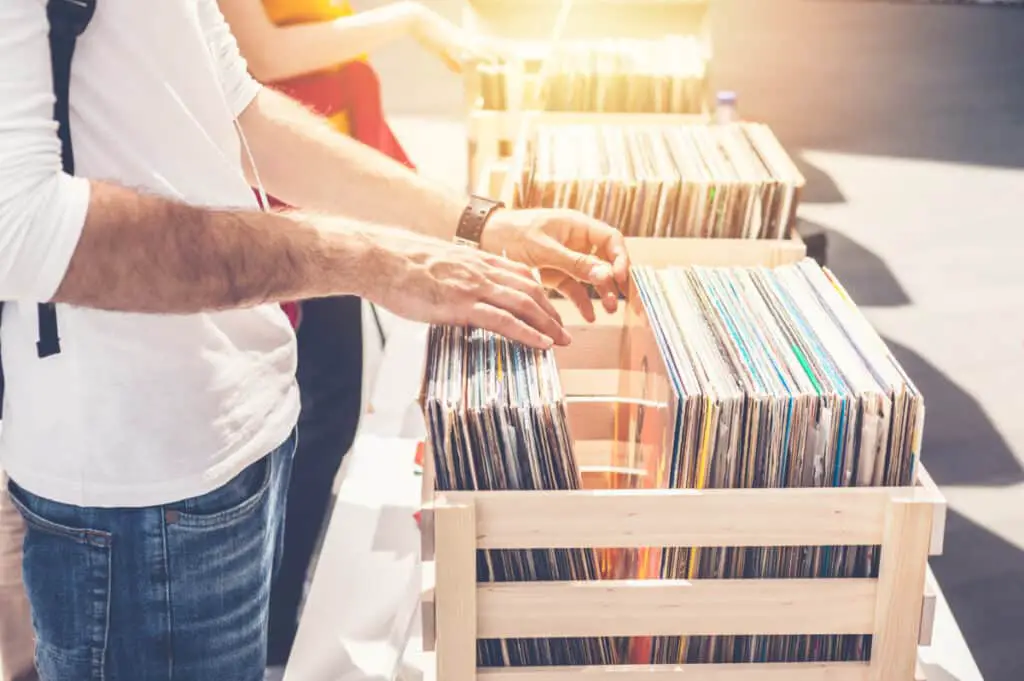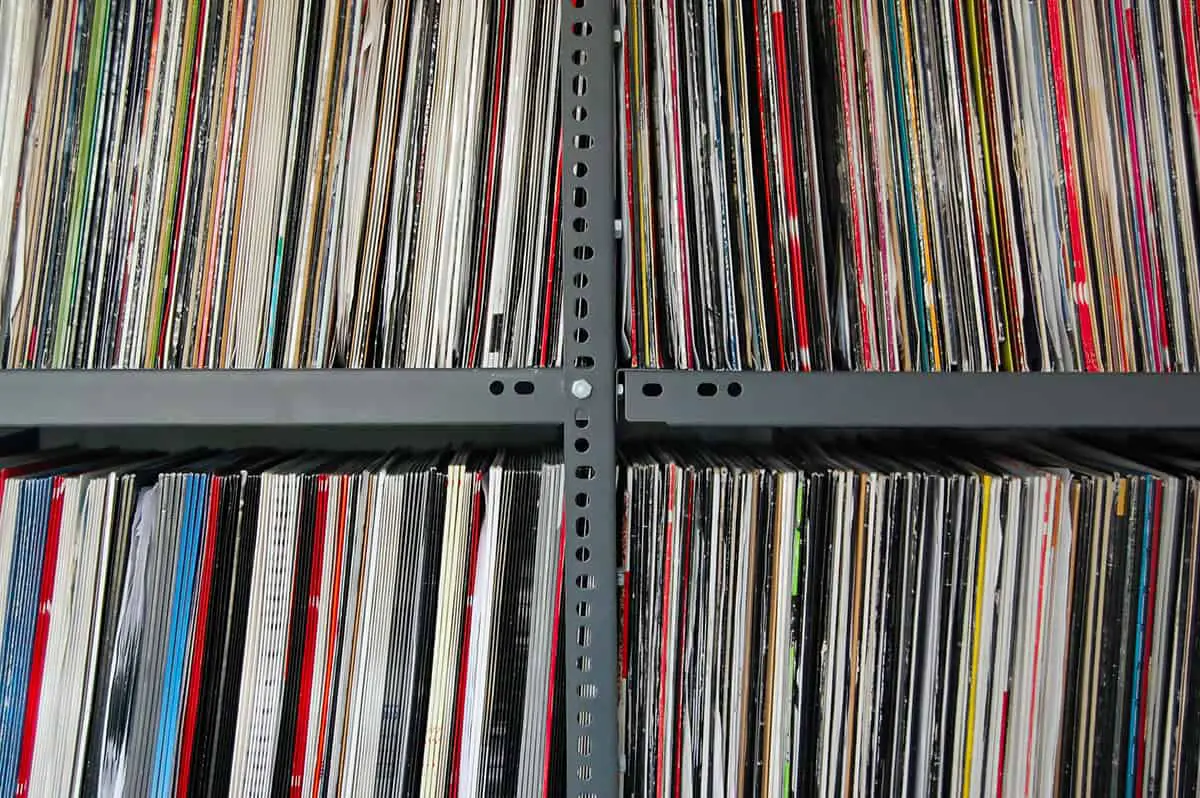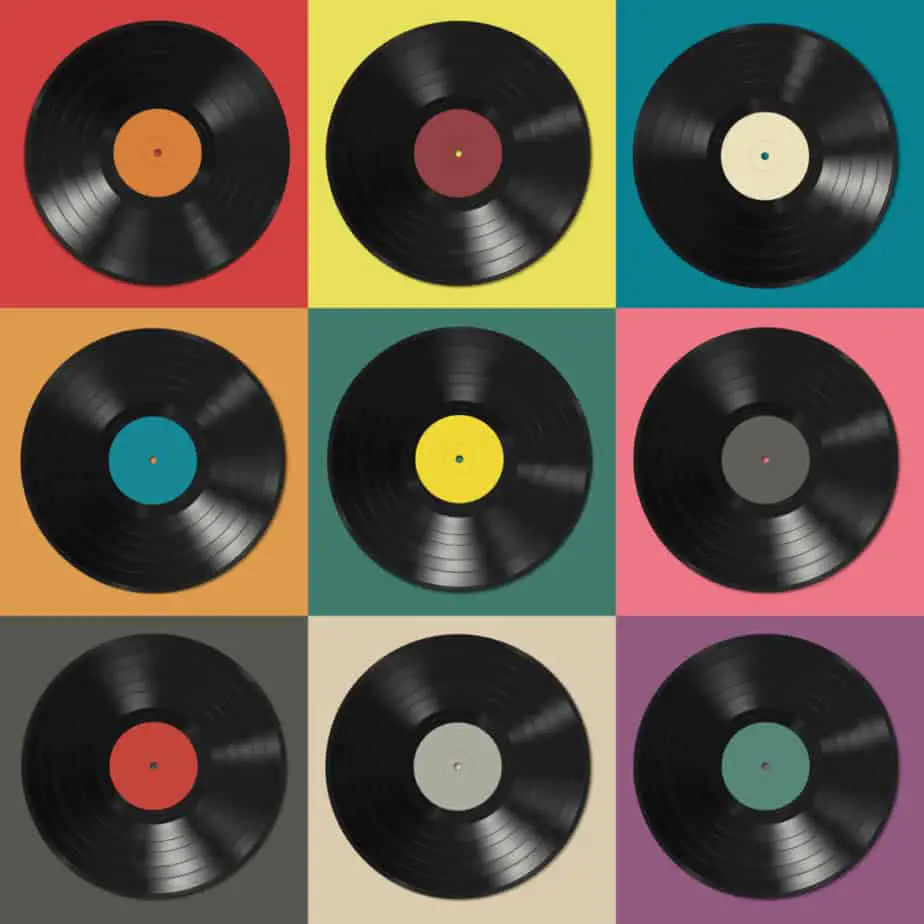This post contains affiliate links.
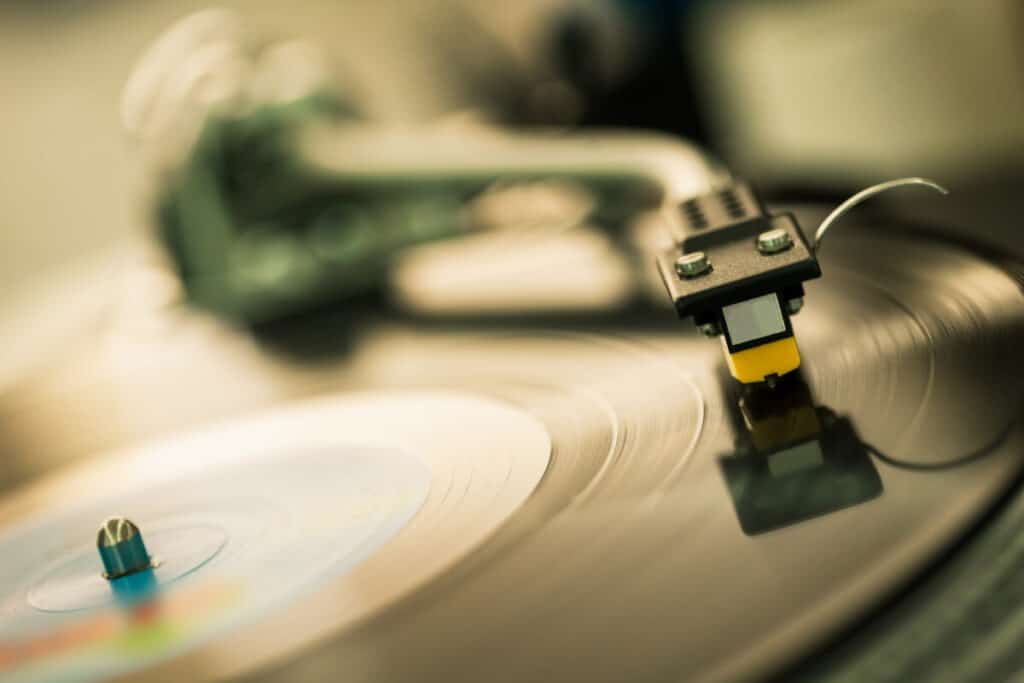
Your vinyl collection has finally outgrown its designated space, and it’s time to figure out a better place for them. But ensuring the safety of your precious records is hard, especially when there is so much to remember.
What if I told you that storing your records doesn’t have to be stressful, or even difficult?
In this article, we’ll discuss a few storage tips, general care tips, and display tips to keep your record collection safe, clean, and eye-catching.
Table of Contents
Jackets With Sleeves
When it’s cold outside, a jacket without sleeves isn’t what we’re going to reach for, because we know it won’t help. This is the same concept with your records. A cardboard jacket can’t totally protect a record. This is why record sleeves have come into practice and popularity.
There are two types of record sleeves. First, the inner sleeve. This one goes over the vinyl record as the first layer of protection. For an inner sleeve, you’ll want the material to be smooth and silky. Other materials- paper-like sleeves, for example- will scratch up the surface of the vinyl. Once the inner sleeve is over the record, it will go inside the cardboard jacket.
Next, we have the outer sleeve. This is similar to the inner sleeve in that it needs to be smooth and silky in material and feel. The outer sleeve will help protect from dust buildup on the vinyl and its jacket. You’ll want to make sure that your outer sleeve is also lightweight. A heavy one could end up sticking to and eventually peeling pieces off of the jacket.
If you don’t want to have multiple sleeves, you can try vinyl bags. These are similar to outer sleeves in that they go over the cardboard jacket. However, vinyl bags can also seal and become airtight, better helping to protect from dust, dirt, and anything else that could antagonize your records. If you like the sleeve idea and you want to give your vinyl that extra 10% of protection, try adding a vinyl bag on top of the sleeves.
Temperature
There are several factors that can affect your records, including temperature, light, and humidity. Temperature is perhaps the most major of these because vinyl records are incredibly sensitive to heat- within minutes they can be rendered completely unusable. As a general rule, lower temperatures are safer for your records.
The recommended temperature for records to be stored at is about 46-50°F. Anything above 50 degrees can start warping your records. This isn’t a hard and fast rule, though. For the records you play daily, the collection can be stored in temperatures from 65-70°F. That said, for long-term storage, 50°F and under is the best temperature range to keep your vinyl safe.
Related articles
What Temperature Can Vinyl Records Withstand? We Have The Answer.
This Is The Temperature In Which Records Warp
Light
Light is another important environmental factor to watch out for while deciding where and how to store your vinyl records. Records should not ever be directly exposed to light, whether it’s intense or not. But that doesn’t mean that you need to keep your records out of all light, though that would be kind to the vinyl. A good principle to follow is to keep the vinyl out of direct light as much as you can- minimal exposure is key.
Direct exposure to light can, like high temperatures, start to warp your vinyl. This is because direct light does have heat, whether we can feel it or not.
Humidity
Similar to temperature and light, humidity can also create heat and, therefore, warping effects in your vinyl collection.
The biggest key to this is keeping air flowing. Fans and air conditioning are both great options to assist with this. And another tip: don’t store your vinyl in the attic or the basement. You may have noticed that neither of these areas has good air circulation, and they sustain more extreme temperatures, because attics and basements are more affected by outside temperatures. This is not good for vinyl, so try to keep it in a spot where there is consistent airflow and not a lot of humidity.
Vinyl loves a dry environment. By dry, we mean anywhere from 35-40% relative humidity (RH). Anything more than that can create a greenhouse-like effect on the vinyl, like higher temperatures and more water in the air.
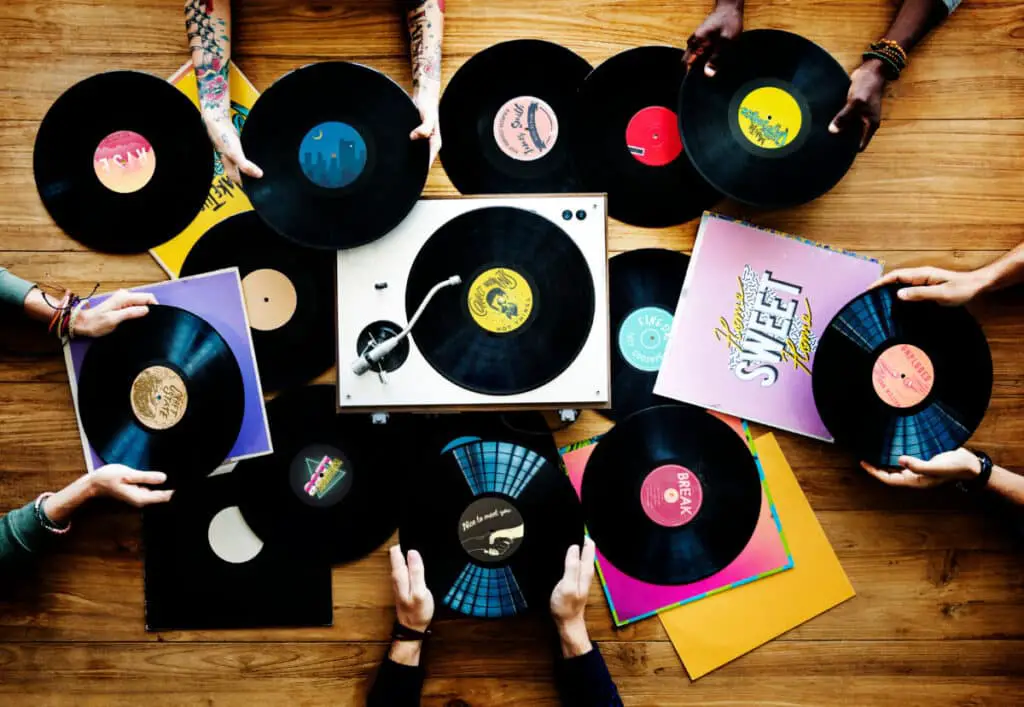
Cleaning and Care
The way you clean and care for your vinyl collection also has a big effect on the records. A record cleaning brush is a great way to keep your records clean. True to the name, these brushes are specific to cleaning records, so they have no problem getting into those grooves and cleaning out any dust or dirt that has gathered while it was out of its jacket and sleeves.
You may be the type of person that cleans their records on their t-shirt and calls it good, and if so, this next part is for you. Cleaning the record with your t-shirt is not good for the record. Even if the shirt is super comfy and soft, fibers in the shirt can still scratch the vinyl.
Another great cleaning option for your vinyl is a vinyl cleaning solution that comes as a simple spray. For use, you can just spray the solution onto the record. Make sure to stay clear of the record label! Then, gently wipe down with a microfiber cloth. Using this cleaning process every 6 months will keep your records looking nice, shiny, and most importantly, clean!
As a general rule, don’t touch your records with your hands (unless you’ve carefully washed and dried them first). Even after being washed, and especially before, hands have so many oils in and on them, and these act as a trap to catch all the dirt, dust, and debris. Think of handling your vinyl collection as you would handle a hard copy of a photograph. Touching the photograph damages it, right? It’s the same case with vinyl: the oils in our hands are harmful to the material.
Using finger cots or clean nitrile gloves while cleaning will help to keep fingerprints and oils off of the vinyl, give you a better grip, and assist in keeping the vinyl records clean. If you’re just playing your records, make sure to wash your hands first, and try to only touch the edges of the record.
Boxes
Boxes and bins are great storage options, especially if you don’t play your records super often. If you’re storing your records in a box, make sure it’s not in a cardboard box. Cardboard boxes aren’t as strong as other materials and they can break easily. A better option would be a heavy-duty plastic box. Crates and baskets are also some great, more stylish, options.
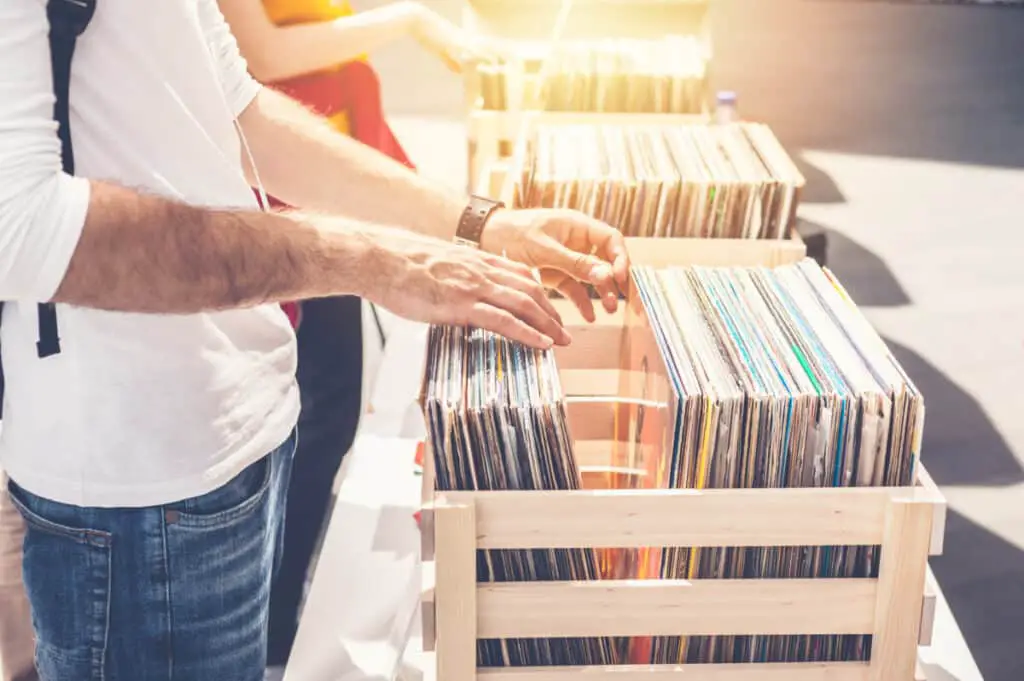
There are also several airtight options, some that are specifically designated for record storage. These are great for transporting your collection during a big move, but for permanent storage, these are also not the greatest option. Though they’ll keep the records safe, airtight boxes have no airflow, which can contribute to higher or lower temperatures and other components that can compromise your records.
Shelving
Because there are so many types of shelves, they have a lot to offer. Shelves can be fun accents, function as beautiful accent furniture, provide useful storage, and so much more. These uses make shelves the perfect candidate for vinyl storage. We’ll further discuss how to style different types of shelves later, but here’s a list of shelving do’s and don’ts for your vinyl collection.
- DO install metal brackets under the corners of shelves. Shelves aren’t mean to hold too much weight, especially floating ones. Give your shelves a little extra power by adding brackets underneath them.
- DO group your vinyls together by size. You may already have a great organization system, whether it’s by color, genre, or artist, but trust me on this. Grouping records together by size will not only make the shelves aesthetically pleasing to look at, but it will also assist in evenly distributing weight among shelves.
- DO use labeled dividers in between groups. This one isn’t necessary, but for the inner perfectionist and organization master in all of us, it makes tracking down the record we’re wanting so much easier.
- DO store your vinyl records in an upright position. This will eliminate pressure on the vinyls and keep them happy.
- DON’T touch your vinyls! If you must touch them, wash and dry your hands first. And please, just touch the edges. The oils in your hands can cause damage to your records.
- DON’T stack your records on top of each other. Pressure isn’t good for records. This is another factor that can cause warping and other complications in the records.
- DON’T store in direct sunlight. You may have an empty shelf on the wall, but if that wall gets tons of sun, that is not the place for your vinyl collection. Direct and intense light can cause major warping problems in vinyls.
- DON’T put away vinyl records before cleaning them. Nobody wants to see a buildup of dirt and dust, and it’ll start to affect how they play after going too long without cleaning.
Some Display Tips
Vinyl records are becoming a very popular way to decorate, whether you’re into collecting them or not. We’re seeing them pop up in college dorms and on prominent display in homes, bringing some nice vintage, retro, or sometimes even boho vibes to the room. It all depends on what they are styled with.

Crates have always been an interior design staple. You may be surprised to hear that they have a history with storing records- people used to use milk crates as record storage because they fit the records perfectly. Now, though real milk crates are incredibly hard to come by, putting your records in a cute crate would add a touch of history to the space.
Open shelving units are another great way to store records. A great example of these is the KALLAX shelves from IKEA. These have so many functions, and you’re able to either put the records straight into some shelves and put baskets in the other shelves to add a bit of balance and keep some things out of sight and out of mind.
Related Article:
Great IKEA Hacks for Storing Vinyl Records
Floating shelves are another fun way to store your vinyl records. There are so many types, ranging from wire racks bent into fun shapes to the basic, clean-cut wooden shelves we all love. You can either prop up a few records on the shelves, slide them into the racks, or you can combine them with other design elements like cute plants, stacked books, and figurines. Floating shelves are easy to overload, so be careful to not put too much weight on shelves that are holding your collection (or any other valuables).
Wire magazine racks (and designated record racks) that can stand in a corner are another great way to store records. Be careful of storing yours in one of these, though, because overloading the angled shelves could cause pressure on the records that are on the bottom.
There are also so many great end tables that can be used to store records. With the rise in people looking for beautiful and functional furniture, stylistic and functional shelves seem to be incorporated into everything, including those tiny tables on the sides of your sofas.
If you want to display your records on the wall, you could purchase a pretty picture frame and display the record on a wall without lots of sunlight. This will give a little bit more of a sophisticated, art-gallery vibe to your decorating.
Another super fun option is to mount your records on the wall without a frame. Twelve Inch sells an amazing wall-mount made for vinyl records specifically. It comes with two magnetic pieces, one on the wall and one on the jacket of the record, that allows for easy attachment and removal. This is perfect for those that want their favorite vinyls displayed prominently, but want to be able to listen to those favorites with ease.
VacationVinyl.com is a participant in the Amazon Services LLC Associates Program, an affiliate advertising program designed to provide a means for sites to earn advertising fees by advertising and linking to Amazon.com. We also participate in other affiliate programs which compensate us for referring traffic.

